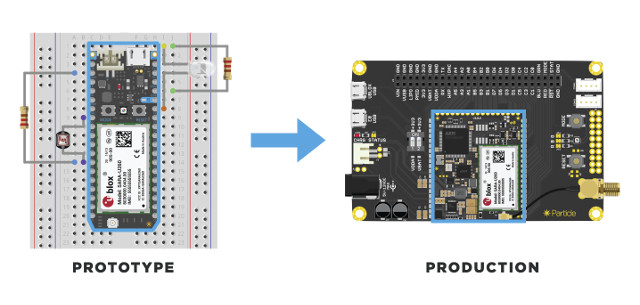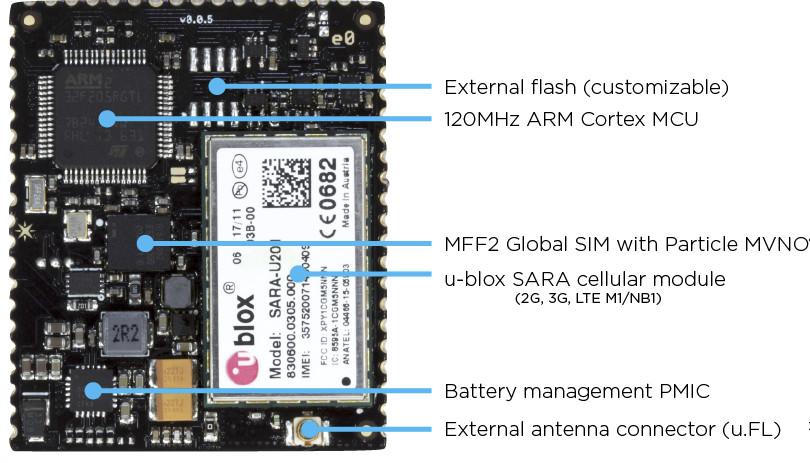Cellular IoT has really taken off this year from the low cost Orange Pi 2G IoT board to 4G GPS Trackers, and global IoT SIM cards. Particle has been in this market for a couple of years, starting with their Electron boards, and the company has just announced the new Particle E series family of industrialized 2G, 3G, and LTE-enabled modules and a development kit.
Key features of Particles E series modules:
- Cellular Connectivity
- u-blox SARA modules for cellular connectivity
- LTE: SARA-R410M
- 3G: SARA-U201/U260/U270
- 2G: SARA-G350 (2G)
- Embedded SIM card, Particle MVNO support in 100+ countries
- u.FL antenna connector
- u-blox SARA modules for cellular connectivity
- MCU – STM32F205RGT6 120MHz ARM Cortex M3 microcontroller with 1MB flash, 128KB RAM
- Storage – • Expandable flash memory
- I/Os – 63-pin surface mountable castellated module with up 30x GPIOs, 12x ADC, 2x DAC, 13x PWM, 3x UART, 2x SPI, 1x I2S, 2x CAN, 1x USB 2.0 (Some signals are multiplexed)
- Power Supply – 3.88 to 12V input; BQ24195 power management unit and battery charger; MAX17043 fuel gauge
- Power Consumption (@5V?)
- Operating current (cellular ON): 180 mA to 250 mA
- Operating current (cellular OFF): 47 mA to 50 mA
- Peak current: 800mA (3G), 1800 mA (2G)
- Sleep Current: 0.8 mA to 2 mA
- Dimensions – 43 x 36 x 4.6 mm
- Weight – < 10 grams
- Temperature Range – -20 to +85°C (extended range)
- Certifications – FCC, CE, IC wireless certifications, PTCRB (End-Product Certified) & GCF cellular certifications, RoHS
A total of 7 modules are planned to launch by mid 2018 with the naming convention using the first number reserved for the “G” number, the second for local (0) or global (1), and the third being an incremental number:
- E210 – 2G only – Q4 2017 working worldwide (quad band)
- E301 – 3G with 2G fallback – Q4 2017 for Americas/Australia (850/1900 MHz)
- E302 – 3G with 2G fallback – Q4 2017 for Europe, Asia, and Africa (900/1800/2100 MHz)
- E310 – 3G with 2G fallback – Q4 2017 working worldwide (850/900/1800/1900/2100 MHz)
- E401 – LTE M1 – Early 2018 for US (LTE B13)
- E402 – LTE M1 – Early 2018 for North America (LTE B2/4/5/12)
- E410 – LTE M1/NB1 – Mid 2018 for the global market

The new modules share the same software development tools, Particle Cloud platform, code and peripherals as Electron prototyping board with the modules running FreeRTOS, supporting CoAP encrypted messaging, TCP/IP and UDP/IP, GCC toolchain, and various firmware update methods including OTA. E series were created because while Electron board suitable for evaluation, pin-row headers, plastic SIM cards, and USB connectors made it less appropriate for integration into products and mass production.
The company has also introduced an E Series evaluation kit working globally with the following specifications:
- Module – Particle E310 3G with 2G fallback
- Breakout Board with
- 2x micro USB port for flashing and serial communications
- SMA antenna connector
- 1x female expansion header, 2x Grove connectors
- Misc – MODE and RESET buttons, Charge and status LEDs
- Power – Li-Po battery connector, power barrel jack
- Battery – 2,000 mAh Li-Po battery
- Antenna – Taoglas penta-band antenna (u.FL), SMA to u.FL adapter for connecting external SMA antennas
- 1x Grove temperature sensor
- 1x USB Micro cable
- Pinout reference card
The kit will come with three months of Particle’s 1MB monthly data plan upon eSIM activation. Data plan pricing depends on the country of operation and number of nodes, but for reference, for up to 100 nodes in the US, you’d pay $2.99 per month/device including 1MB data, plus $0.99 per extra MB.
Pricing information has not been publicly disclosed for the module, but you can purchase E series development kit for $99.99, or $249 with 3 extra spare E310 modules. Visit Particle E-Series product page for further details.

Jean-Luc started CNX Software in 2010 as a part-time endeavor, before quitting his job as a software engineering manager, and starting to write daily news, and reviews full time later in 2011.
Support CNX Software! Donate via cryptocurrencies, become a Patron on Patreon, or purchase goods on Amazon or Aliexpress





“Cellular IoT has really taken off this year…” Not for me where I live (Indonesia). There are ZERO affordable SIM cards or plans for something like add as you go IoT devices. You MUST have one SIM card per IoT device. Postpaid cards are way too expensive, but you don’t have to manually top them up every month. Prepaid cards are a little less expensive (but still too much), but you have to remember to top them up every month, all of them, a real hassle when when each card expires on a different day (which inevitably happens). Where the… Read more »
have u tried tri? i know the coverage not as good as those top 3, but you can extend its validity, 8000 for 4 months
@Drone
What about the hologram card? It does not come with a phone number by default, so I guess it should not be a problem with authorities if the card is not registered (like tourist with roaming SIM card do not need to register), so SMS with a normal phone will not work, but you can still use data or SMS using their API.
In Indonesia the SIM card and data plan is very affordable. I could buy a new SIM card for about IDR 10 000 (about USD 0.75), For IoT I would use daily data plan IDR 1 500 (USD 0.12) / 100 MiB (too too much for IoT). There should be an AT command to call *123*w*h*a*t*e*v*e*r#. So I could just buy cellular credit for IDR 50 000 (USD 3.71) monthly. The op-cell name is 3, btw. Well, it’s not very reliable — lost signal sometimes, server error, etc — but I think that’s okay. There is always Telkomsel if you… Read more »
@Jean-Luc Aufranc (CNXSoft)
Tri = Hutchison 3 Indonesia.
https://en.wikipedia.org/wiki/Hutchison_3G
I’ll take a look at what they offer new. But the last time I looked, 3 would still cost me every month around maybe 50,000 and automatic top-up was not reliable. Thanks.
@Gung Sukma Bpk. Gung, The problem is the monthly cost, even if you use zero data. At least around 50,000 Rupiah/bulan. That may seem OK for one or two IoT devices, but it adds up to LOTS of money if you have many IoT devices. Even one house can have ten or twenty devices, especially for HVAC and alarm systems. And as I have said above, I have found automated top-ups to be unreliable. Therefore, you still have to log on all the time to check if the top-ups are working. So why not top them up manually anyway. What… Read more »
IDR50k US$3.71 per month cannot be named expensive. You simply don’t add GSM module on each device, just have one to be used by all devices. Conect them by bluetooth, wifi, LoRa, etc, or even cables or anything free. If your data is so low, then don’t buy any data plan and it will be IDR1 or IDR2 per KiB. Then you need to buy credit just to keep your card active, may be IDR 10-20k per month. For your problem, have your device check the credit and report to you when it is low. Then just go to abang-tukang-pulsa… Read more »
@gung sukma “Seem like you have a very big house” An example application is a small to medium sized apartment building with many walls. The area is too large for BT, and WiFi is not ideal due to needed extenders and congestion. The building management doesn’t supply Internet to the tenants, it’s not a hotel. What is needed is a low-rate M&C system for: fire sensors/alarms/sprinklers, timed area lighting control, elevator alarm monitors, and door access control. The building is too small for a wide area CCTV network. There are many thousands of small to medium sized buildings like this… Read more »
@Drone
Are you allowed to use a Singapore SIM card in Indonesia using roaming without registering the card with local authorities? If so, Hologram works the same way, as roaming needs to be enabled for it to work. The company claims to have partnerships in Indonesia. Once you connect it will show “name of local operating | hologram”.
About your use case, it might be possible to use Bluetooth Mesh protocol with a cellular gateway. Just need to wait a little longer for ready to use BT Mesh solutions. There are just some devkits right now.